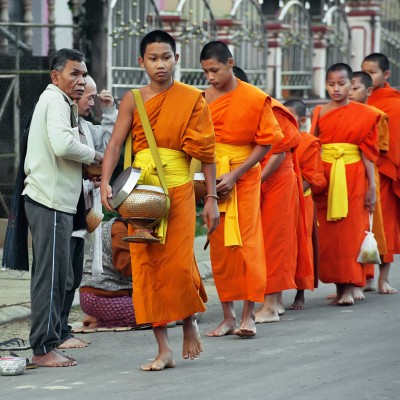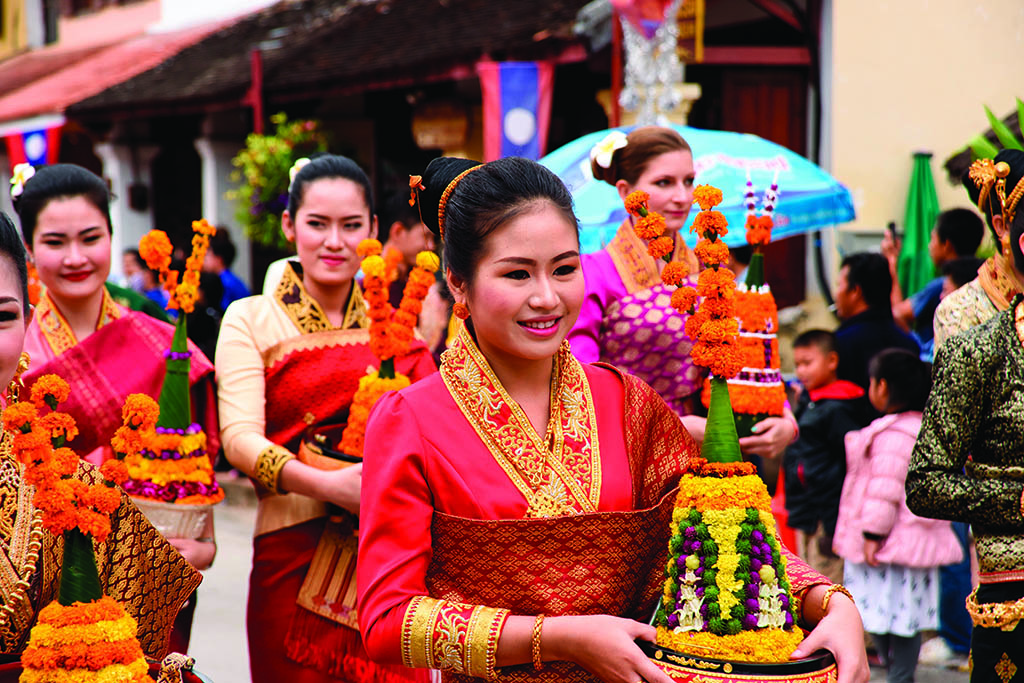There’s an old Buddhist proverb that reads: “Do not dwell in the past, do not dream of the future, concentrate the mind on the present moment.” In Laos, that traditional adage isn’t taken loosely, and it may be the country’s most alluring quality. While the proverb suggests spiritual awareness, it’s a reflection of Laos as a destination. Visiting the country is visiting its history. Here, the past is the present, and the future will only be what the country has already become. Laos embraces an unchanged landscape and culture, where acceptance in traditions doesn’t budge to an onslaught of tourism. There’s no millennial-wooing full moon parties or decadent hotels with bells and whistles. There’s no star-chef restaurants or hokey tourist attractions. In the modern age of travel, these may seem like setbacks, but it works to Laos’ advantage, locked in with a timeless appeal that you’ll be hard-pressed to find in other major cities in Southeast Asia.
There are no monotonous, cookie-cutter hotels, just charming properties and B&Bs that have tons of soul. The Laotian cuisine—sticky rice, fresh fish, marinated meats, brilliant spices—is one of the most underrated cuisines in the world. And the cultural events make visitors feel like they’ve stepped back in time. In Laos, there’s something for everyone. Nature enthusiasts can trek through pristine forests and underground caves; hardcore foodies can experience bizarre dishes; and culture junkies can explore hundreds of temples embellished by modest young monks setting the scene.
The landscape in general is that of a fairy tale: think brooding jungles and limestone cliffs, unspoiled riverside villages, and dense cities with very little towering buildings. Laos is incredibly simple yet overwhelmingly exciting. While some travelers continue to say Laos has been forgotten, it has inarguably worked to its advantage; more travelers are seeking off-the-radar, ends-of-the-earth adventures, and Laos is the ultimate destination.

Buddhist Monks by Perfect Lazybones
All the action is central to Laos’ most famous city, Luang Prabang. In fact, most travelers and locals will agree that Luang Prabang is Laos. It’s chockfull of iconic Southeast Asian street food and centuries-old monasteries, ubiquitous saffron-robed monks, and fascinating, low-key night markets. Here, the unexpected is the norm and even the norm is unexpected. Luang Prabang is a mysterious, intriguing city that time may have forgotten, but travelers are starting to take notice.
Luang Prabang’s history dates back to 1353, but it didn’t get much attention in the Western world until the French occupied Laos as a unified territory in 1907. To this day, you can see French influence in the architecture and cuisine (often merged in both, considering many European-style cafés peculiarly serve Laotian food). If you ask any ex-pat who has lived in Laos for more than ten years, or any backpacker who has returned to the country since the 1990s, they’ll whole-heartedly say that Laos has not changed.
Locals aren’t sure when Luang Prabang began to attract more tourists, though fingers point at UNESCO who stamped the ancient city as a World Heritage Site in 1995. Since, Luang Prabang has been exceptionally friendly to foreigners, and it’s a one-stop destination when traveling to Laos. All things one would seek in a Laotian adventure are prominent in Luang Prabang: Buddhist temples, cafés and riverside restaurants, outdoor adventures, thriving markets, and excellent hotels.
Luang Prabang’s claim to fame and most notable feature for tourists is its spellbinding monk culture. More than 65 percent of the 50,000 inhabitants identify with Buddhism, which is the primary religion of Laos and practiced heavily today. Monasteries and watts are an important focus on social life, and Buddhist ceremonies are on the regular. Like Hinduism in Bali, Buddhism is central to Luang Prabang’s cultural identity, interwoven with daily rituals and life in general (Buddhism marks the national symbol; the gilded stupa of the Pha That Luang temple is on the state seal.). These quiet monks (typically orphans) are spotted throughout the streets, working on temples, meditating, and participating in the ever-famous monk processions. Every weekday morning around 5 A.M., as sunlight breaks beyond the Phou Thao mountains, monks walk the streets gathering alms from locals that patiently offer them, a rare and fascinating tradition that dates back to the 14th century. A blessing to experience and observe, the morning procession is considered Luang Prabang’s main attraction as it’s a visual representation of a city rooted in Buddhism.


20th anniversary of Luang-Prabang World Heritage Site by Santiti Chanpeng
With monks in mind, one doesn’t visit Luang Prabang without checking out the number of well-preserved shrines, temples, and monasteries, many dating back hundreds of years. Phu Si Hill is one of the most famous temples, and a popular tourist attraction in itself. It sits 330 feet high atop a hill in the center of town, so panoramic views are enormous, giving visitors the lay of the land and the perfect photo opportunity of breathtaking landscapes. A visit here takes effort considering some 200 steps, but it’s worth the climb. As if you couldn’t feel more spiritually awakened in a city like Luang Prabang, the ascent is calming and meditative, and, from the top of Phu Si, many travelers reflect on their lives. The vantage point is crowned by a gilded stupa, That Chomsi, which, from ground level, seems to float in the air. Visitors can also check out the original, 19th-century murals inside Wat Pa Huak, an untouched temple that conjures ruminating moments from decades past.
The city’s most regarded monastery is Wat Xieng Thong, built in the 16th century and surrounded by stupas and small chapel halls on the bank of the Mekong River. The gilt work of Wat Xieng Thong is mesmerizing and lavish, and the roofs sweep low to the ground, dramatically enhancing its design. Quite often, depending on the time of day, visitors can spot monks congregating in and out of the monastery.


